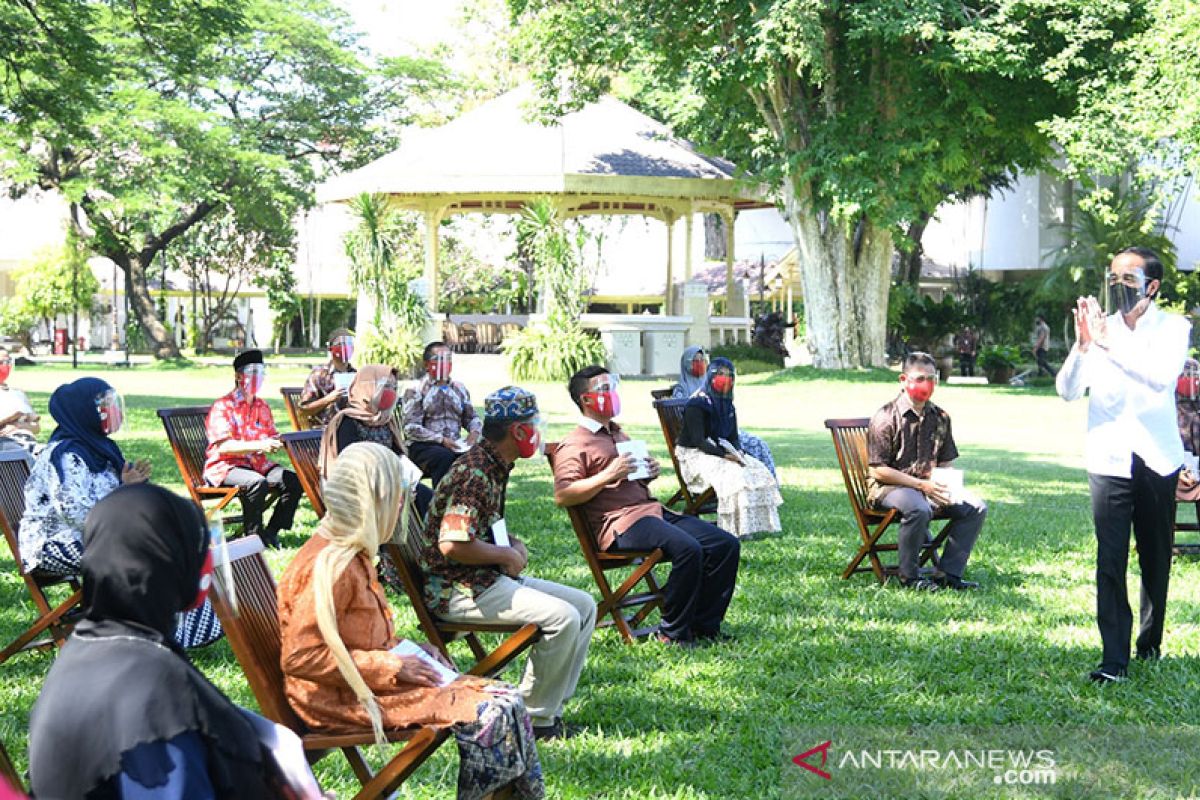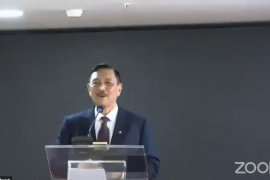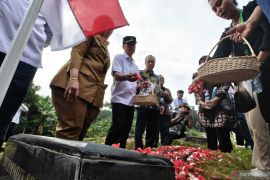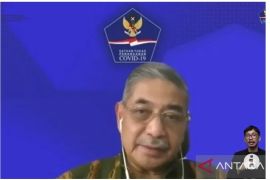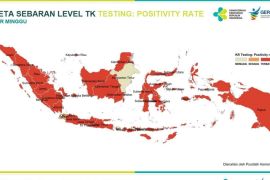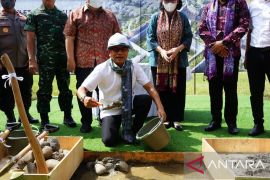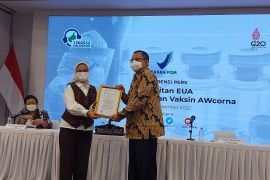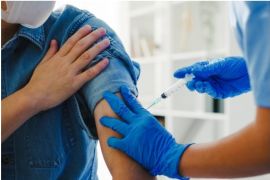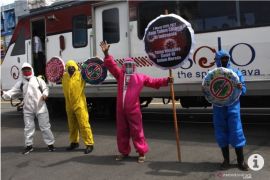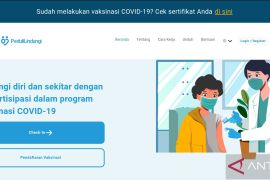However, since the work-from-home guidance was implemented in response to the COVID-19 pandemic, the mobility of his customers has trickled to a stop, and so has Nahrowi's source of income.
"(Amid the pandemic) I get nothing because people are no longer hanging out," Nahrowi said when asked about his income. Before COVID-19 struck, he was earning Rp 600 thousand (around US$40.7) per day from selling instant coffee and snacks.
Another vendor, Narsih, who sells herbal medicines to workers in the Kebayoran Baru area of South Jakarta, is facing a similar problem. As the pandemic continues, she is feeling the need to find a way to generate additional income to cover her expenses.
Following the government's regulation to curb virus transmission, many of her customers are no longer going to office. Others have been affected by the layoffs introduced by companies, many of which are experiencing financial difficulties.
Many business establishments have closed down or cut operating hours amid the implementation of large-scale social restrictions in Jakarta.
These drastic changes have resulted in a reduction of more than 50 percent in Narsih's turnover. Nowadays, she is managing to earn just Rp150 thousand (around US$10) per day.
“It is really hard to find customers nowadays,” said Narsih, who has been selling herbal medicines for 20 years.
Nahrowi and Narsih are portraits of the people whose livelihoods have been directly affected by the outbreak of the SARS-CoV-2 virus, which causes the novel coronavirus disease.
The disease has had a huge impact on Indonesia's microeconomic sector on account of restrictions on physical interactions, weakening of supply and distribution chains, as well as health problems.
There are countless micro entrepreneurs like Nahrowi and Narsih in Indonesia who have been affected by COVID-19. The country has 63.3 million micro entrepreneurs, who dominate the total micro, small and medium enterprises (MSMEs) sector, according to data published by the Cooperatives and SMEs Ministry in 2018.
The social and economic situation due to the COVID-19 pandemic has put great pressure on people from the middle and lower economic class in several countries. This does not yet include the impact of losses suffered by farmers and fishermen, who are both producers as well as consumers.
According to data provided by the Central Statistics Agency (BPS), the number of poor in Indonesia had reached 24.79 million as of September, 2019. The National Development Planning Agency (Bappenas) has estimated that by 2020, the number of poor could increase to 28 million people, or 10.62 percent of the total population in Indonesia, if there is no significant intervention from the government.
Already a recession?
What Nahrowi and Narsih are currently experiencing is a symptom of an economic recession, when real income has decreased and industrial activity has been sluggish. Added to this fact are the many layoffs that have made the economic multiplier effect disappear.
The government's prediction has confirmed that Indonesia will enter a technical recession during the third quarter of this year (July-September). Last week, the government had forecast that economic growth in the third quarter would be in the range of minus 1 percent to minus 2.9 percent, which, effectively means Indonesia is experiencing a recession.
In fact, the symptoms of a recession have been experienced since the beginning of the year, when Indonesia recorded a slowdown in real Gross Domestic Product (GDP) growth.
On an annual basis, the economy in the first quarter of this year only grew 2.97 percent, while the quarterly figure was recorded at minus 2.41 percent. The government should have anticipated this because, in the last decade, this was the first time the country's economic growth had dipped below five percent.
Indeed the definition of a recession is always predicated on a negative economic pace over two consecutive time periods, or quarters. But, do the differences in negative and positive numbers in measures of economic growth provide a significant gap?
If the economic cycle is like a wheel, the recession phase is the rotation after the peak of the cycle to the trough of the wheel. There are two questions we need to currently focus on: whether we are really approaching the trough of the wheel, and how do we get past the trough and climb back into the recovery phase.
And if we have not reached the bottom of the wheel, are we ready for the trough?
If we use the government's scenario, now, at the beginning of the fourth quarter of 2020, we should have passed the bottom and prepared to move up the recovery phase.
However, some economic data, such as the consecutive deflation during July-September, 2020 and the stagnation of the Consumer Confidence Index, do not seem to support the government's scenario to run smoothly.
The possibility of a sharp V-shaped economic recovery in Indonesia is running low. There is a bigger likelihood of a recovery that is V-shaped, but with a more gentle right slope, not steep. This means that the country's economic recovery will not proceed on a fast curve. The thing to watch out for is if the recession phase is long (U-shaped), or even, erratic (L-shaped).
The World Bank, in its latest study, has predicted a contraction in Indonesia's economy by minus 1.6 percent to 2 percent for 2020 — the first time economic growth has been negative for the entire year since 1998.
Keynesian economic theory states the importance of aggregate demand as a driving force for the economy. Consumption, which drives economic cycles, must be supported by government spending, especially when the economy is sluggish.
Upper-middle group support
When the economic slowdown occurred, people from the middle to lower economic classes, such as Nahrowi and Narsih, became a particularly hard-hit segment in the country. Thus, it is not surprising that the government has decided to expand social safety net programs to deal with the impact of COVID-19.
According to data from the National Economic Recovery (PEN) task force, as of September, 2020, the government has spent Rp318.5 trillion (US$21.6 billion), or 45.8 percent of the Rp695.2-trillion (US$47.1 billion) budget for handling COVID-19 and responding to the economic slowdown.
However, the consumption and saving patterns of the people present a contrast. Data from the Financial Services Authority (OJK) and the Deposit Insurance Corporation (LPS) shows that public savings in banks, with great nominal amounts, are actually increasing.
As per the latest data, in August, 2020, banking third party funds grew by 11.64 percent on an annual basis (yoy). This growth showed a continued trend of accumulating funds in banks in July, 2020, when the growth in deposits reached 8.53 percent (yoy).
Looking deeper, the highest growth in deposits occurred in the group of deposits with a nominal value of more than Rp5 billion, which grew 15.2 percent (yoy) to Rp3,186 trillion. Then, the group of Rp500 million to Rp1 billion grew by 10.1 percent (yoy), and the group of savings of Rp200 million to Rp500 million swelled 9.5 percent (yoy).
It seems that the growth in deposits from big customers is a relief, but it has other implications: the large amount of funds being deposited in the banking sector will slow down an economic turnaround. This has also been exacerbated by the unsatisfactory functioning of banking intermediation.
Of course, the government needs to tackle the problem of slowing consumption. One way to do this is by encouraging the middle and upper middle class groups to increase spending, rather than concentrating on saving.
If the middle and lower classes have been stimulated by various social safety nets so that they can improve their purchasing power, even to the point of President Joko Widodo continuing to widen the deficit of the annual state budget, the middle class needs to be given the confidence to safely carry out economic activities in the middle of the pandemic.
This is where the “health first, economy will follow” commitment from President Widodo's administration will be tested.
The concerns of the middle-high income group must be reduced by increasing the capacity of testing for COVID-19, positive progress in developing the COVID-19 vaccine, proper planning for COVID-19 immunization, and enforcing health protocols in economic activities, such as shopping and tourism.
People, including Nahrowi and Narsih, are awaiting the results of their progressive efforts to escape the recession.
Related news: Finance Ministry outlines three strategies for avoiding recession
Related news: Jokowi emphasizes three steps to tackle global recession
Translator: Indra Arief/Yashinta Difa
Editor: Gusti Nur Cahya Aryani
Copyright © ANTARA 2020
